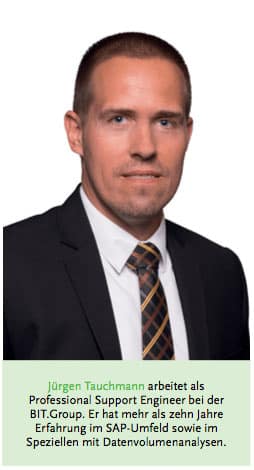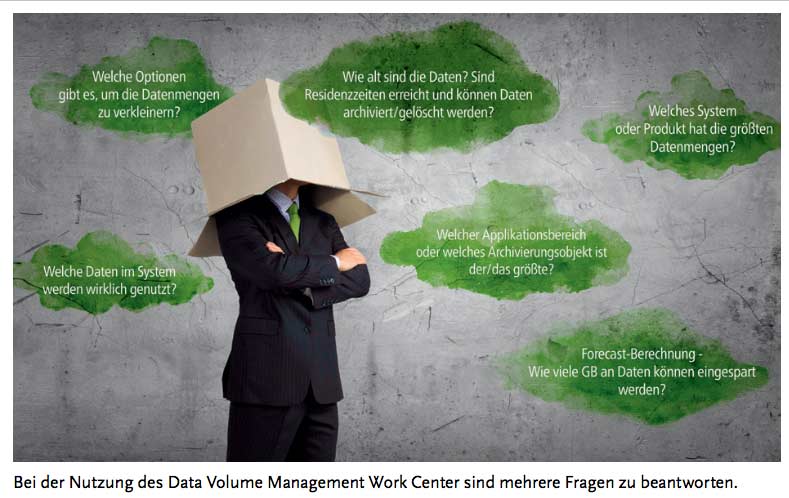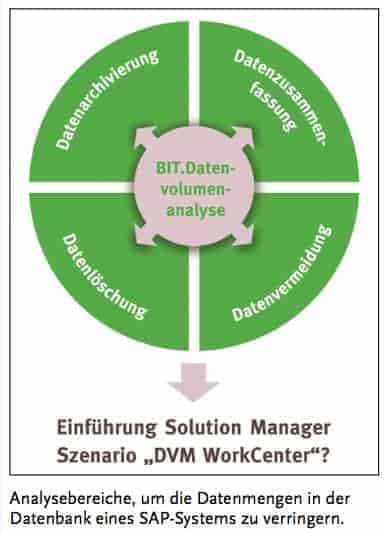Data volume analysis in SAP systems


The classic concept of Enterprise Resource Planning (ERP) is also being replaced by SAP Business Suite for Hana.
In this way, SAP aims to simplify the operation of the systems and thus reduce the Costs for the end customers.
In addition, the business benefits are to be increased through better networking of the components and higher speed in the processing of the tasks assigned to the SAP system.
In order to optimally plan and design a project, there are some important points to consider before switching to Hana or S/4 Hana.
As a rule of thumb, the smaller the Databasethe lower the administrative Effort and the lower the Costs for the Hana-certified hardware. Accordingly, only Data migrated that are relevant for the business process.
In addition to reducing the amount of data in advance of a Migration to Hana or the introduction of a Hana scenario, it is also necessary to keep the database size at a constant level during the ongoing operation of an SAP system without a Hana scenario.
Regular data maintenance results in several benefits: Through less Data in the SAP system, administrative time is saved for Back-up, reorganization and recovery are lower. As a result, large cost savings can be realized.
The smaller the Database of an SAP system, the fewer downtimes are required for system and database maintenance, thus increasing system availability.
The traversal of long-running transactions often shows that, despite suitable access plans and sensible selection, a large part of the processing time ends in read table operations.
Ensuring that only valid and required records need to be read has a positive effect on system performance.
An overview of the data distribution in the SAP system allows those application areas with the largest data volumes to be tracked down.
From this, strategies can be developed as to how these Data can be avoided in the future, for example by adapting the system customizing of the application.
There are also recommendations on how application data can be summarized. Furthermore, the housekeeping jobs and the existing archiving strategy are analyzed. Also before upgrading SAP systems or Migrations from Databases the focus is on the topic of data reduction.
Here too, the smaller the Database, the lower the Efforts for the project, both in terms of the Costs as well as in administration.
The Data are examined for potential in the areas of data archiving, data deletion, data aggregation and/or data avoidance. In order to find out which path is the right one, first the Data in the Database are considered and their data distribution and structure are analyzed.
Among other things, the focus is on the question of when these were created. After this consideration, it should be clear which areas have the greatest potential and should be analyzed first. 
The four options above are not available for every data area, as there are Data there is, for example, no further need to keep them in the long term. These can be deleted. In addition, it may be necessary, by means of specific settings, to delete these Data to be avoided in perspective.
The counterpart to this is Datawhich have a certain retention period due to legal regulations. Here, primarily only data archiving comes into consideration, however, also the summary of this Data be an option.
How exactly can such a data volume analysis be performed? The best option is to use SAP experts. They perform their work in close coordination with the customer. Concrete and meaningful recommendations for action are given, which the customer can then implement in his SAP system. Retention periods of the various Data is, for example, information that is the focus of the Analysis and are not known to every customer.
Especially if customers feel unsure or do not have much experience in the area of data volume analysis, the support of SAP experts is advisable, because when dealing with the sensitive Data in the SAP system should not be experimented with.
An example from a data volume analysis from the end of 2015 provides remarkable results. The SAP system of a large media group with a database size of over 2.5 terabytes was examined.
Within the scope of this Analysis savings potential of 1.2 terabytes was found, i.e. almost 50 percent of the total size of the Database. Savings of this magnitude cannot be guaranteed, of course, but double-digit percentages of the analyzed data areas are usually the rule.
Furthermore, there are tools available to customers that can be used in data volume analysis.
We are talking about Solution Manager, which can be used to simplify a number of steps considerably by creating data volume management self-services.
Such a self-service is then implemented with Data fed from the SAP system and, thanks to automated background routines, provides valuable results with regard to archiving, deletion, summarization or avoidance of Data.
But here, too, experienced archiving experts should provide support during self-service and finally check the results before they are implemented in the SAP system.
As the figure above shows, there is yet another way to analyze and monitor the Data in SAP systems. A tool called "Data Volume Management Work Center" is available in SAP Solution Manager for this purpose.
It is based on SAP NetWeaver BW and, if configured correctly, provides an overview of data distribution within SAP landscapes to identify areas where, for example, it is necessary to set up a data volume strategy.
In addition, there is the possibility to see which reduction potentials are possible with a moderate or more aggressive approach. So there are hardly any questions left unanswered about data distribution in the SAP landscape and the possibilities for data reduction.
Furthermore, the "Data Volume Management Work Center" offers the functionality to perform regular monitoring including extensive reporting functions.
In principle, any SAP system with Database different, which means that the experts have to adapt to changing situations each time and take this into account in the Analysis meet.
Aim of the Analyses is to identify and point out short-term reduction potentials of data volumes and to limit data growth in perspective.
In summary, as described, in various scenarios, be it S/4 Hana, upgrades, Migrations on Hana or other Databasesas well as the daily administrative work of a Database important to understand the volumes of data in SAP systems and their Databases and keep them as small as possible.
Only the absolutely necessary Data should always be available. This saves time for administration and thus Costs saved.




